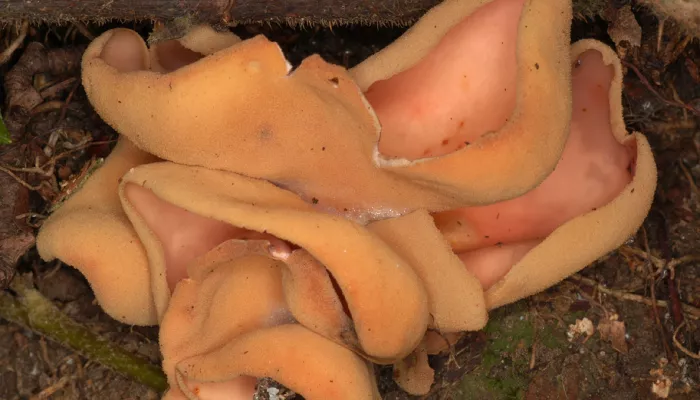| Statistics | |
|---|---|
| Cap diameter: | 1cm - 5cm |
| Stem height: | up to 1cm |
The hare's ear is a cup-like fungus that grows in clusters in broadleaved and mixed woodland, often near to the path. Its orange colour makes it quite conspicuous in the leaf litter.
About
The hare's ear is a distinctive fungus of deciduous woodlands. The ear-shaped cups appear in groups on the soil and leaf litter of mixed and deciduous woodlands, often near to paths. Fungi belong to their own kingdom and get their nutrients and energy from organic matter, rather than photosynthesis like plants. It is often just the fruiting bodies, or 'mushrooms', that are visible to us, arising from an unseen network of tiny filaments called 'hyphae'. These fruiting bodies produce spores for reproduction, although fungi can also reproduce asexually by fragmentation.
How to identify
The hare's ear displays large, lopsided 'cups', with slightly inrolled margins. The inner surface of the cups is smooth and pinkish-yellow to orange in colour. The outer surface is paler buff in colour. It has a short, hairy basal stem.
Did you know?
The hare's ear fungus grows throughout mainland Europe.
How people can help
Fungi play an important role within our ecosystems, helping to recycle nutrients from dead or decaying organic matter, and providing food and shelter for different animals. The Wildlife Trusts manage many nature reserves sympathetically for the benefit of all kinds of wildlife, including fungi: you can help by supporting your local Trust and becoming a member. Our gardens are also a vital resource for wildlife, providing corridors of green space between open countryside. Try leaving log piles and dead wood to help fungi and the wildlife that depends on it. To find out more about encouraging wildlife into your garden, visit our Wild About Gardens website: a joint initiative with the RHS.

